In the 1270s BC, the Assyrian king Shalmeneser I mounted a campaign against a group of eight countries in the Lake Van/River Zab area, and defeated them. This marked the beginning of nearly seven hundred years of hostility between Assyria and Urartu. The principal reasons for conflict were the desire of both states to control the lucrative trade routes between the Mediterranean and the East in northern Syria and the encroachment of Urartu's southern border ever closer towards the Assyrian principal cities. Less than two hundred years after Shalmeneser another Assyrian king Tilgarth-Pileser I led a campaign into the whole western part of the Armenian highland and defeated sixty kings of 'the lands of the Nairi'. Significantly Tilgarth-Pileser avoided entering the area around Lake Van, the stronghold of the Urartian kingdom, even at this early stage.
MAP A
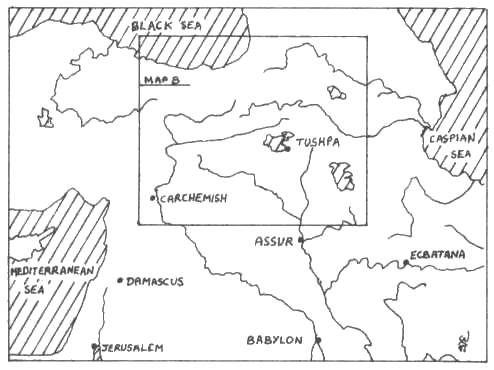
MAP B
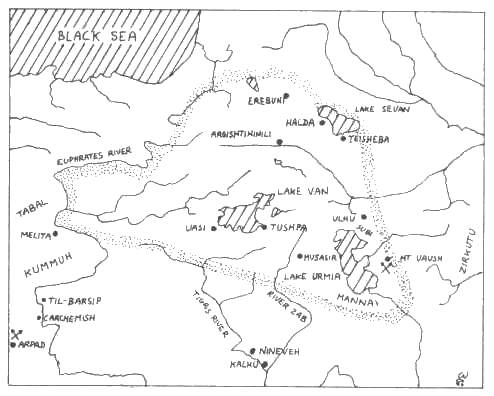
The maps and figures
Map A shows some of the principal cities of the Near East. The rectangle shows the area covered by Map B. Map B indicates the maximum extent of the Urartian kingdom by a dotted line. Some of the principal towns and cities are also shown.
During the second half of the ninth century BC, Shalmeneser III (860-825BC), the king of Assyria, led three campaigns into the Lake Van area, capturing Sugunia and the sacred city of Arzasliku. However, the combination of Urartu's growing strength and resilience and a temporary waning of Assyria's might prevented the complete destruction of Urartu. By the end of the ninth century BC Urartu had developed into a state which at times during the next two hundred years provided some real opposition to Assyrian domination, and indeed outlasted its great foe.
The Urartian king Menua (810-781BC) continued the work of previous kings, Sarduri I and Ishpuini, erecting fortresses, strengthening Tushpa, the capital of Urartu (see Map B), and copying the techniques of war utilised by the Assyrians. For the first time the state became centralised and a ruling class emerged. The advantage was beginning to pass to Urartu.
Argishti I (781-760BC), son of Menua, continued the expansionist policies of his father. He carried out an expedition to the west in an attempt to achieve an outlet to the Mediterranean and to capture the main trade routes through northern Syria, which were controlled by Assyria. The governor of Til-Barsip (see Map B), a town allied with Assyria. started sending worried letters to the Assyrian capital, but Argishti achieved his aim and the trade routes were his. He also expanded northwards, first building the city and fortress of Erebuni, and later founding Argishtihinili, a city surrounded by strong defensive works. Urartu was reaching its zenith by the end of Argishti's reign. The kingdom was established in the west, in the Lake Urmia region, and in the north. More significantly the smaller countries of northern Syria, such as Kummuh, paid tribute to Tushpa and the Urartians had control of the trade routes. This coincided with Assyria's military and economic demise: for the time being at least.
Sarduri II (760-743BC), son of Argishti, continued building towns and fortresses and strengthening the country. In 745BC, Tilgarth-Pileser III became king of Assyria. He reorganised the army and the economy and started reconquering the lost areas. In 743BC he moved westwards and defeated an army of Urartians (with Agusi, Melita, Gurgum and Kummuh allies) some 60,000 strong. Sarduri had to flee back across the Euphrates. In 735BC, Tilgarth-Pileser III had built up his forces sufficiently to penetrate Urartu land itself. Apparently he met no resistance on entering the country and he laid siege to the fortress at Tushpa into which the city garrison had fled. The siege of the fortress failed and he satisfied himself with destroying the surrounding city and returned to Kalhu (see Map B).
Rusa I (734-714BC), came to the Urartian throne at a time of difficulty. Many of his regional governors were pushing for independence from Urartu and the Assyrian threat had to be guarded against. He tightened up the administrative system, replaced the governors with loyal viceroys, rebuilt the fortresses. At first he turned his attention northwards as marauding nomadic tribes of Scythians and Cimmerians had descended from the Caucasus. Rusa built two fortresses to help stem the tide at Halda and Teisheba (see Map B) and at the same time sought to avoid direct conflict with the Assyrians so as to give his nation a real chance of recovery. Shalmeneser V, the king of Assyria, acquiesced in this as he was having problems of his own at home. For a short period Urartu recovered almost all of its previous strength.
However, in 722BC Sargon seized the Assyrian throne from his brother. Sargon first defeated the Egyptian Pharaoh Sabaka in the south, and then turned his attention northwards. Meanwhile Rusa was having problems at home and he had to put down a revolt of his generals at Tushpa, the capital city. Flushed with his success, Rusa started covert activity against Assyria and control changed in several of the border countries between Urartu and Assyria. In 714BC Sargon decided that he had had enough of these intrigues and sent an army into Urartu, crossing the border to the east of Lake Urmia (see Map B). The army descended into Mannai, but then turned eastwards towards Zikurtu (see Map B) to persuade the ruler of this border state to change his allegiance to Assyria. Sargon then learned through his spy-network that Rusa and his allies had approached his rear and were drawn up in the gorges of Mount Uaush (see Map B). He received specific information as to the disposition of the Urartian forces and mounted a surprise attack. His sudden burst into the enemy camp at the head of a massed chariot and cavalry charge caused panic in the ranks of the Urartians and he gained a total victory. Many of the Urartian noblemen cavalry were taken prisoner. Sargon laid waste the eastern side of Lake Urmia, including the district of Subi where Urartian cavalry horses were bred, and the important town of Ulhu was destroyed. Sargon then made for Lake Van, but passed Tushpa by and made a surprise attack on the strategic town of Musasir, which the Urartians had used as a base for raids into Assyria itself. The town was looted with some 333,000 items being carted off by the Assyrians. It is said that Rusa killed himself in anguish when he heard of what had happened to Musasir.
Argishti II, son of Rusa, succeeded to the Urartian throne and tried to make good the losses of war. Left alone by the Assyrians, he made great advances since by 708BC Sargon had to deal with the king of Kummuh who was once again paying tribute to Urartu. After Sargon's death in 705BC Assyria was thrown into turmoil enabling Urartu to gain a respite in which to recover yet again. Argishti founded a new town at Tushpa on the hill of Toprakkale and a new powerful fortress was built on the banks of the upper Euphrates as a base to protect the newly captured trading routes between the Mediterranean and the east.
Rusa II, son of Argishti, maintained friendly relations with the increasing numbers of nomads pushing into the area. He continued the construction work and expanded his control of the trade routes.
Little is known of the final years of the Urartu kingdom. It is known that Urartu sent emissaries to the Assyrian capital in 654 and 639BC, the two states having established an uneasy peace. The Assyrian were more concerned with Elam and Babylon, and ultimately with their own survival. Five kings are known to have ruled the diminishing realm of Urartu after Rusa II. In 609 and 607BC the now dominant Babylonians mounted brief campaigns against Urartu, which probably did little more than accelerate its decline. However, it was the Scythian hordes which overran Urartu and by 585BC the kingdom had ceased to exist as a separate political entity.
It can be seen from this resumé of the history of the area that the Urartians and Assyrians held great respect for each other. Warfare between the states broke out when the Assyrians saw the Urartians as threatening the trade routes in northern Syria; when the Urartians extended their boundary too far south; when Urartian strength grew too great for Assyrian peace of mind, and when the Urartian kings decided that they could challenge Assyrian dominance of the area.
Some ideas for wargaming the conflict between Urartu and Assyria
There are some interesting elements of the conflict which could be included in a campaign game, and might influence a wargame between fairly small armies using figures.
First, Urartu essentially only had to deal from two threats; namely, Assyria in the south, and the Scythian and Cimmerian tribesmen from the north. On the other hand, the Assyrians had to cope with the threat from Urartu in the north; individual city-states which attempted to throw off the Assyrian yoke; and from Elam, Palestine and Egypt to the south.
Second. although all states in this area at this time had well-organised spy-networks. the Assyrian system was by far the best. Thus, the Assyrian player should be given greater knowledge of the disposition of the enemy forces and their size and content. Simultaneously, some method should be employed to allow the Assyrian player a greater chance to unleash surprise attacks.
Third, during periods of relative peace, the Urartians proved themselves to be very competent at rebuilding their armies and fortresses. They aimed not only to make good the losses of war, but also to make improvements so as to lessen the chance of defeat in the future.
Fourth, Assyria had the better-organised and larger armies to put against Urartu when the threat from the other parts of their empire was not so significant. However, the Urartians were quick to copy the techniques of the Assyrians.
Fifth, Urartu had to rely on fairly large numbers of troops from allied states within and on the border of the kingdom which could not be totally relied on.
Finally, although this part of the Near East is very mountainous, both armies tended to choose flat areas in which to join battle almost by mutual consent. This was so that they could both make the best use of the military resources and techniques they possessed. However, this terrain would have the effect of slowing down armies on the march, and provide more opportunity for ambush.
The armies of Urartu
After watching their Hurrian armies decimated by the well-organised and well-armed Assyrian armies, Urartian kings adopted many of the facets of Assyrian armies of the period. Specific details of army organisation and tactics are very sketchy, so the following information, although based on what is known, is not very comprehensive. Certainly Urartian armies would have developed the three usual arms of ancient armies: namely, units of chariotry, cavalry and infantry.
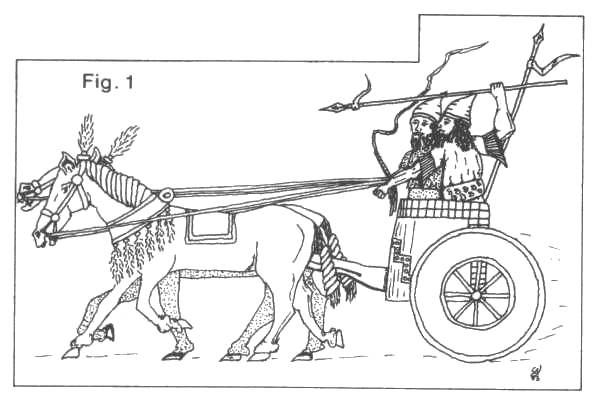
Figure 1: This is a representation of an Urartian two-horse chariot as depicted on contemporary bronze shields and scabbards. The chariot is made of wood and painted. The central shaft could end in a bronze horse's head (one has been found). Primitive leather tyres were wrapped around the wheels, both charioteers wear bronze helmets, and the spearman has a bronze waist belt depicting religious scenes. The ribbons on the spears could well have been used for signalling.
Urartian chariots were of the light two-horse variety. It is known that the Urartians had two distinct breeds of horses, and from contemporary depictions of chariots, it would appear that the smaller of these breeds was used to pull the chariots. Thus they would not have been very fast-moving. Chariots are depicted as containing an unarmed driver and a spearman, who in some cases in the later period would have worn some scale armour covering the upper torso. The spearman has the use of two spears, and a bow and a quiver of arrows. Chariots would have been organised probably in units of twenty to thirty, and used in conjunction with the cavalry as the primary strike force to charge into ranks of infantry and hopefully put them to flight.
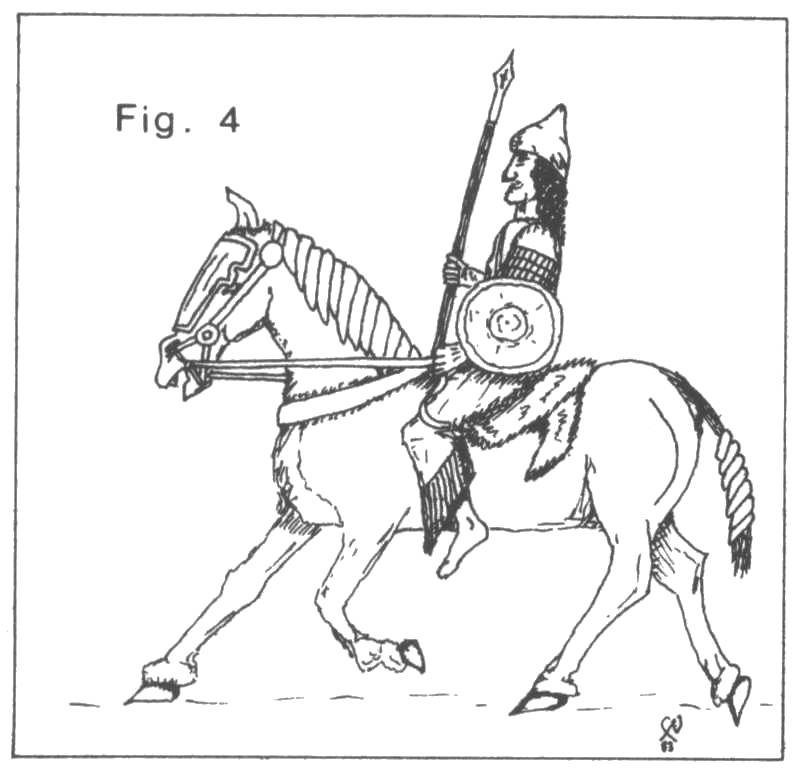
Figure 4: This picture represents a mounted nobleman. The horse has an iron or bronze plate covering its forehead, similar to that used by the Scythians. The animal skin on the horse's back would commonly be sheep or goatskin although lions were prevalent in this area at this time, and a higher noble could well have a lionskin saddle cloth. The small shield and the helmet are bronze. The spearhead is iron.
The cavalry were noblemen who would have the opportunity to do some rudimentary training. They would have been archers or spearmen, probably grouped together in mixed units of fifty to a hundred. Cavalry horses were bred in the district of Subi (see Map B), to the east of Lake Urmia, and were larger than the chariot horses. The destruction of this area by Sargon no doubt greatly weakened the effectiveness of Urartian cavalry thereafter. Archery was a favourite past-time of the Urartian ruling classes so there is some reason to believe that their horse-archers were particularly effective.
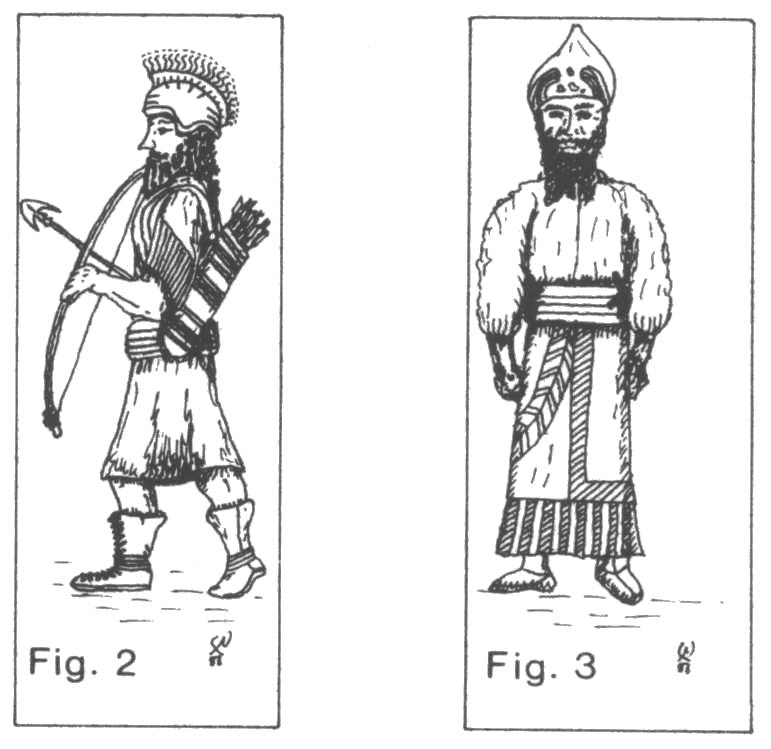
Figure 2: This is a light archer. He is wearing typical Urartian laced boots with wide brims. The bronze helmet has a small woollen crest. The Assyrians adopted the crests on their helmets from the Urartians. The shirt and kilt were woven from wool or flax. They would be either a natural colour or coloured with a natural dye such as reddish-brown, dark yellow or dull green. Light spearmen often carried wicker shields.
Figure 3: This is how an Urartian king may have appeared. The helmet is bronze with representations of gods and demons. The jacket is woollen and lined. Popular colours amongst ruling classes in this period are purple and dark blue. The boots are leather and the belt is bronze.
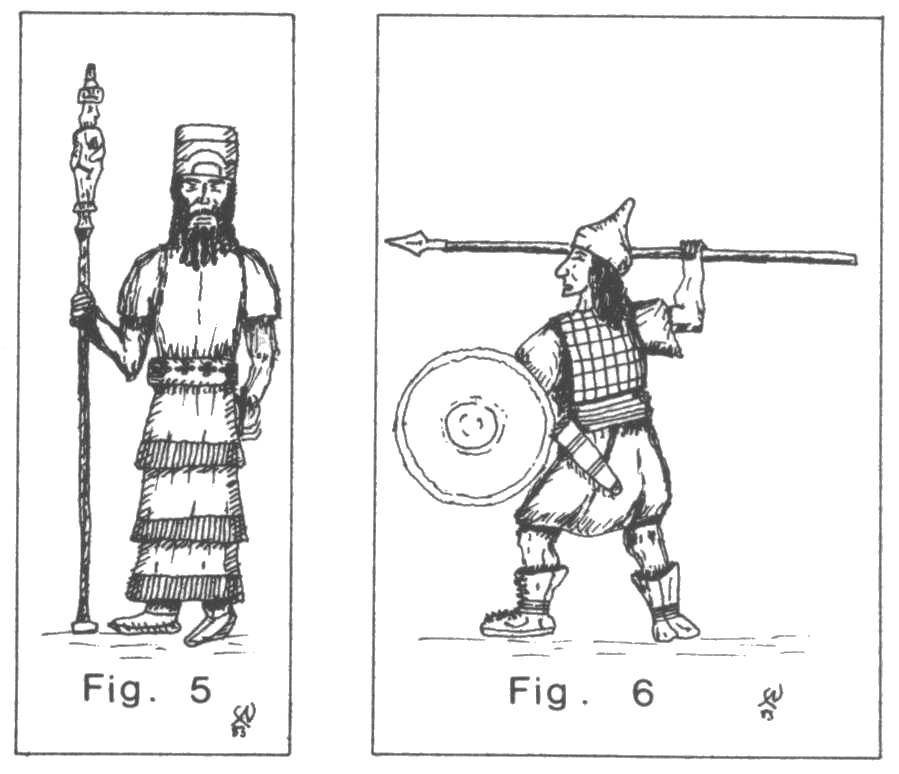
Figure 5: This is a standard-bearer, perhaps a priest. He carries a wooden staff which is topped with a bronze figure of the god Haldi, one of the three principal Urartian deities.
Figure 6: This picture represents a heavy spearman. He has a fairly large bronze shield with a central boss. The helmet and scabbard are also bronze. Bronze swords were common in the early part of Urartian history, but by Sargon's time the great majority were iron. This fighter wears a leather jerkin with iron plates sewn on to it.
The infantry would have consisted of units of spearmen, archers, slingers and swordsmen. The spearmen would have made up the mainstay of the army, perhaps as much as two-thirds of the infantry. However, as mentioned before, the Urartians were keen archers. Indeed even the Assyrians commented that they were the finest archers that they had ever come across. It might be the case, therefore, that Urartian armies contained a large proportion of archers. In any case, it would not be unrealistic to give Urartian archers an advantage in accuracy and range over their foes. Slingers and swordsmen would have made up only a small proportion of the army. Large quantities of scale armour have been found and it would be reasonable to assume that one in four or five of Urartian infantry would be organised in units of medium-heavy infantry to defend against chariotry and cavalry charges.
Urartian armies included fairly large numbers of troops from allied states. Such troops were not reknowned for their skill or their desire to stay on the field of battle to the bitter end. For the last hundred and fifty years or so of the Urartian kingdom, units of Scythian horse archers fought in their armies. Such units also fought alongside the Assyrians, suggesting that they could change sides if they found themselves on what they thought was the losing side.
Bibliography
The Ancient Civilisation Of Urartu - B. Piotrovsky.
Everyday Life in Babylonia & Assyria - H. W. F. Saggs.
The History and Culture of Urartu - B. Piotrovosky.
The Evolution of Weapons and Warfare - T. N. Dupuy.
Armies & Enemies of Ancient Egypt & Assyria - A. Buttery.
Other Urartian Resources:
Urartian Bronze quiver & helmet: embossed with horsemen and chariots, belonging to Sardur II, 7thC BC. State Hermitage Museum, St Petersburg
Urartian Plaque with Chariots and Footmen, Metropolitan Museum of Art, New York
Belt fragment at the Metropolitan Museum of Art, New York
Medallion with a seated deity and a male worshiper at the Metropolitan Museum of Art, New York
Bronze helmets at the British Museum
Decorated bronze shield at the British Museum
Urartian collection at the Museum of Fine Arts Boston
Fragment of a Urartian Armour at wikipedia commons
Urartu Chariot at wikipedia commons
Bronze Gates at Balawat showing the conquest of Urartu by Shalmaneser III in 859 BC
Urartian Buildings
Statuette of soldier. Urartian, 8th-7thC BC. Musée du Louvre
Silver vessel with warrior struggling with leopards, Marlyk. c. ninth century BC, Archaeological Museum, Teheran
84. Urartian West Iranian Infantryman, in Armies and Enemies of Ancient Egypt and Assyria by Alan Buttery
87. Urartian West Iranian Chief, in Armies and Enemies of Ancient Egypt and Assyria by Alan Buttery
Sculptures of Sargon II at Khorsabad, showing West Iranian Warriors:
. Detail of Bas Relief 18, Sculptures of Sargon II at Khorsabad, Room 2 - West Iranian chief and warrior with wicker shield in The Assyrians capture Ganguhtu, Bit Bagaya, and Kiundau, and accept the surrender of Tikrakka, in 716BC
. Detail of Bas Relief 19, Sculptures of Sargon II at Khorsabad, Room 2 - Dying West Iranian warrior in skin-cloak and laced boots
. Bas Relief 22, Sculptures of Sargon II at Khorsabad, Room 2 - The Assyrians capture Ganguhtu, Bit Bagaya, and Kiundau, and accept the surrender of Tikrakka, in 716BC
. Bas Reliefs 1-2, Sculptures of Sargon II at Khorsabad, Room 14 - The Assyrians Besiege and Assault the city of Pazashi (Panzish), in 715BC
. Bas Relief 11, Sculptures of Sargon II at Khorsabad, Room 14 - The Assyrians lead prisoners from the city of Pazashi (Panzish), in 715BC
Leather Helmet of King Sarduri II, 764-744 BC, State Hermitage Museum, St. Petersburg
